Featured Articles
Somebody’s ‘OH’ Must Go? Floyd Has More To Lose Than Canelo
It is a declarative statement that is uttered, and often, whenever two boxers with undefeated records square off.
“Somebody’s `oh’ must go” is the familiar refrain. And that is true in most cases, although it does not account for the possibility of a draw which would leave somebody’s “oh” at least somewhat smudged. In the case of Saturday night’s Showtime Pay-Per-View extravaganza at the MGM Grand in Las Vegas, pitting pound-for-pound king Floyd Mayweather Jr. (44-0, 26 KOs) vs. emerging superstar Canelo Alvarez 42-0-1, 30 KOs), the 23-year-old Mexican sensation already has one standoff on his professional resume (a four-round split draw with Jorge Juarez on June 17, 2006, when Alvarez was only 15) removing the veneer of total perfection.
Maybe the fight – at a mutually agreed-upon catch weight of 152 pounds, five more than the welterweight limit WBC champion Mayweather is most accustomed to and two below the junior middleweight limit at which Alvarez, the WBC/WBA titlist, usually works – will live up to the astounding hype. Alvarez’s 154-pound belts, despite the catch weight, will be on the line.
Many predict that this fight will surpass the record 2.5 million PPV buys for Mayweather’s 2007 showdown with Oscar De La Hoya, which he won on a split decision, and because of higher subscription prices – $64.95 for standard television, an even heftier $74.95 for high-definition – and the fact the bout will be shown in 500 movie theaters around the country, it almost certainly will be the highest-grossing boxing event of all time. But no matter the outcome, Mayweather is assured of a record $41.5 million payday (shattering the previous high of $33 million that Evander Holyfield received for his “Bite Fight” rematch with Mike Tyson), which could rise to $50 million if the more optimistic PPV projections are accurate. Alvarez is supposedly guaranteed a minimum $12.5 million, with that figure apt to jump significantly if the PPV buy rate meets expectations.
To hear the headliners tell it, each man has as much to win, or lose, as the other.
“I think it’s a lot of pressure (on Alvarez),” a supremely confident Mayweather said during a teleconference with the media last week. “Sometimes when there’s pressure, a guy fights better. We have to see how this fight plays out.
“This is a whole different ballgame. (Alvarez) may be predicting a knockout, but all you have to do is look at the opponents he’s faced. And we’re not just talking about `A-plus’ fighters but `D-minus’ and `C-minus’ fighters … guys that he should have knocked out in the fourth round, they were able to go into the eighth and ninth rounds even though they were caught with numerous shots.
“I don’t think Ricky Hatton’s brother (Matthew Hatton, whom Alvarez dominated over 12 rounds in winning a unanimous decision on March 5, 2011) is on the level of a Floyd Mayweather. This is chess, not checkers. These are moves you have to think about. At this level, you’ve got to get 10 steps ahead of your opponent.”
For his part, Alvarez is just as convinced that it is Mayweather who has to be feeling the most heat as he attempts to extend, at the old-for-boxing age of 36, the unblemished record which he frequently cites as proof that he really must be the greatest fighter of all time.
“If I win – when I win – it will change history,” said the red-haired, freckled, pale-skinned Alvarez, who at various times has been described as resembling Howdy Doody, Richie Cunningham and Chucky, said when the question was raised as to which fighter is under the most pressure.
“I think that the way he’s talking, he’s underestimating me. But at the same time, I think he’s worried. I think that he’s very, very worried. He’s always been like that. He’s always been a (trash) talker because that’s the way he is. But I don’t care what he’s saying and I don’t care what he’s thinking. What I care about is what I’m saying and what I’m thinking.”
Opinions will vary, of course, and the prevailing sentiment among those not swayed by emotion or personal preference (like Las Vegas oddsmakers, who have installed Mayweather as a slightly more than 2-to-1 favorite) is that enough of “Money’s” prime remains that he will school the kid as he has done so many previous befuddled opponents. This is the second fight in the 30-month, six-bout deal Mayweather signed with Showtime PPV/CBS in February. His first ring appearance on that contract – which could bring him $250 million-plus if all six fights are staged within the specified time frame — resulted in a standard 12-round decision over an outclassed Robert Guerrero on May 4. Mayweather earned $32 million for that one, although few fireworks were set off. While many analysts applaud Mayweather’s technical artistry, especially his seemingly impenetrable defense, they also are honest in their assessment that he has never been considered a crowd-pleasing “action” fighter who engages in the sort of risk-taking that quickens the pulses of spectators.
So why is Mayweather, if he is indeed too good for his own good, as some have opined, such a box-office smash? Some say it is because of a carefully orchestrated attempt to market himself as a controversial lighting rod that everyone loves or hates, depending on their particular proclivities.
Not since Mike Tyson was offending polite society with his profligate spending and frequently outrageous behavior has any boxer been as much of a proponent of the “If you’ve got it, flaunt it” lifestyle as has Mayweather. In the most recent issue of ESPN The Magazine, he graces the cover and, in the story authored by Tim Keown, it is duly noted that on one shopping trip for even more bling-bling, Mayweather was adorned by $3 million in diamond-and-gold jewelry, including a $1.6 million necklace. He wears his boxer shorts and pricey sneakers just once before tossing them out, and his unwieldy entourage (more than 20 fulltime employees, including four husky bodyguards) are at his constant beck-and-call, even when he fights only once in a given year. And even though he shaves his head, among his team members is a personal barber.
Also reminiscent of Tyson, who owned a fleet of luxury cars despite the fact he ran up hundreds of thousands of dollars in limousine rentals fees, is Mayweather’s fondness for high-end rides. He keeps identical sets of color-coded, ultra-expensive cars at his mansions in Las Vegas (they’re white) and Miami (black), as if to remind himself of where he is at any given moment.
If this is the way Mayweather chooses to roll simply because he can afford it and it suits him, that is one thing. It is quite another if it is the cultivation of an image he has crafted for the purpose of setting himself apart from other elite fighters, as if his abundance of ring skills didn’t already do that. In the spring of 2004, during a brief and ill-advised association with women’s hair-care products magnates Lewis Hendler and Neal Menaged, an attempt was made to make Mayweather more palatable to those Americans who found it difficult to relate to him.
“Our plan is not to tap into the thug image as a way to build Floyd up,” Hendler said prior to Mayweather’s bout with DeMarcus Corley. “We’d like to see him make the transition to mainstream, rather than to pin himself to a particular culture which is fairly limited in terms of marketing potential.”
That plan failed, or wasn’t allowed to succeed, depending upon your point of view. Mayweather quickly broke away from the hair-care guys, and prior to his 2005 fight with Arturo Gatti in Atlantic City, he said that “I am always the villain. That’s all right. I know how boxing works. You have to have a good guy and a bad guy. I don’t mind being the bad guy.”
Leonard Ellerbe, CEO of Mayweather Promotions, seemingly seconded that notion in 2012 when he said, “Floyd is one of the most despised athletes in the world, but he’s also the most talented athlete in the world. What other athlete do you know who has dominated his sport for 16 years?”
Which raises a question. Is Mayweather – despite having zero endorsement deals – the highest-grossing athlete in the world (Forbes magazine had him No. 1 for 2012 with an income of $85 million, a figure he might reach or surpass this year) because of his anti-hero status, or despite it? And is his bleep-you public persona a put-on or for real? There is ample evidence to suggest that what you see, like courtroom appearances and visits to the hoosegow, is really what you get. Mayweather’s running afoul of the law includes the mandatory impulse-control counseling after he was convicted of misdemeanor battery after a confrontation with two women at a Las Vegas nightclub and, most notably, his serving of two months of a six-month sentence after pleading guilty to domestic violence against Josie Harris, the mother of three of his children, in 2011. Had it not been to a plea deal he accepted which resulted in the dropping of additional felony and misdemeanor charges, Mayweather conceivably could have been sent to prison for up to 34 years.
“He just continually gets himself into trouble and he is able to get himself out of it as well,” prosecutor Lisa Luzaich said of the legal trouble Mayweather was embroiled in as a result of the incident with Harris, who accused him of pulling her hair, punching her in the head and twisting her arm. “Essentially it is because he is who he is and is able to get away with everything.”
So here comes Alvarez, with his national-hero status in Mexico and matinee-idol good looks everywhere, an upset victory over the long-standing king of the mountain from becoming the dominant economic force in boxing. He is 23 with a career that comprises much more future than past, unlike Mayweather, who admits to looking no further ahead than the fulfillment of his current contract, and maybe one more bout beyond that if it means making it to the nice, round number of 50-0.
Good vs. evil, as well as young vs. old, are always bankable premises for selling big-time bouts and Mayweather-Alvarez fits comfortably within those parameters. But the paradigm shifts on fight night, when the paying customers expect to be as entertained by what transpires inside the ropes as they were by the compelling story lines going in.
There is the nagging belief in some quarters that the main undercard bout – in which WBA/WBC junior welterweight champion Danny Garcia (26-0, 16 KOs) defends those titles against power-punching Lucas Matthysse (34-2, 32 KOs) of Argentina – could steal the show from the main-event guys. Garcia-Matthysse, because of the attacking styles of the fighters involved, almost assuredly will be exciting for however long it lasts, which might not be the case if Mayweather spends 12 more rounds as a pugilistic Bobby Fischer, grandmaster of chess, toying with a relative newcomer on the brightly lit stage trying to play checkers.
Somebody’s “oh” must go? Yeah, that is important when each participant has as much to win, or lose, as the other. An example of just such a matchup might be the Sept. 16, 1981, welterweight unification megafight between WBA champion Sugar Ray Leonard, then 25, and 22-year-old WBC ruler Thomas Hearns. Those future Hall of Famers were young, undefeated, charismatic and exciting, and Leonard’s thrilling, 14th-round stoppage of the Detroit “Hitman,” while trailing on the official scorecards, gave all that fans could have expected, and more. But while Leonard’s career got a boost from that signature victory, Hearns’ reputation was not necessarily damaged. He had established himself even more as someone the public wanted to see, as is always the case with fighters who unfailingly provide bang for the consumer’s buck.
Is Mayweather-Alvarez apt to be another Leonard-Hearns I, or is it going to be another Mayweather-De La Hoya, which did such booming business yet did not go into boxing annals among the most riveting bouts ever?
Also undetermined is the effect a Mayweather loss would have on both he and his sport. Is there an “out” clause on the part of Showtime/CBS if Mayweather is defeated and thus loses his shield of invincibility? And even if there isn’t such a clause, would he voluntarily choose to step aside if his record were to be defaced by an “L”? Hey, the ESPN the Mag story revealed that he has $123 million in his bank account, which should keep his small army of sycophants on the payroll for quite a while, should “Money” continue to live the ostentatious lifestyle of the rich and famous.
But Alvarez doesn’t need to emerge victorious to remain a viable force. Unless he is emphatically knocked out or embarrassed by Mayweather from the opening bell, he, like Hearns, can be counted on to remain among boxing’s must-see attractions. Defeat is not especially a hindrance to popularity, provided a fighter rates high on the thrill-a-meter. Hearns showed us that, as did the late Arturo Gatti.
Inquiring minds want to see how it all will turn out on Saturday night, when somebody’s “oh” has to go.
-
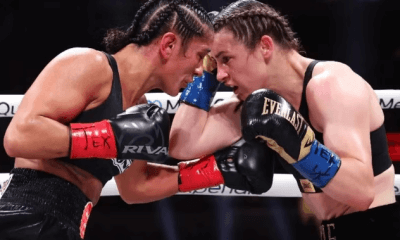
 Featured Articles4 weeks ago
Featured Articles4 weeks agoResults and Recaps from New York Where Taylor Edged Serrano Once Again
-

 Featured Articles2 weeks ago
Featured Articles2 weeks agoThe Hauser Report: Zayas-Garcia, Pacquiao, Usyk, and the NYSAC
-

 Featured Articles5 days ago
Featured Articles5 days agoOscar Duarte and Regis Prograis Prevail on an Action-Packed Fight Card in Chicago
-
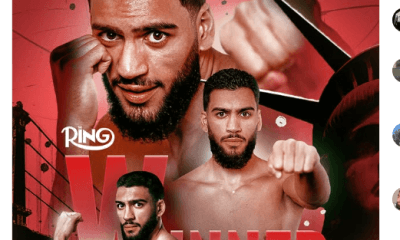
 Featured Articles4 weeks ago
Featured Articles4 weeks agoResults and Recaps from NYC where Hamzah Sheeraz was Spectacular
-
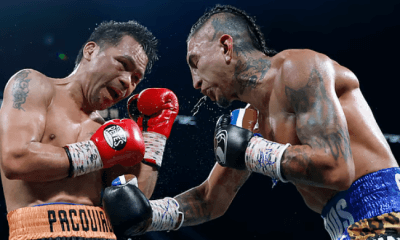
 Featured Articles3 weeks ago
Featured Articles3 weeks agoManny Pacquiao and Mario Barrios Fight to a Draw; Fundora stops Tim Tszyu
-
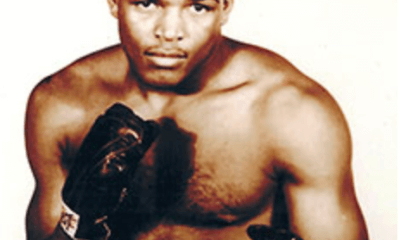
 Featured Articles4 weeks ago
Featured Articles4 weeks agoPhiladelphia Welterweight Gil Turner, a Phenom, Now Rests in an Unmarked Grave
-
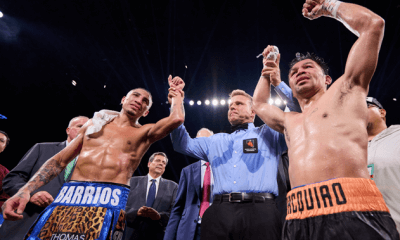
 Featured Articles2 weeks ago
Featured Articles2 weeks agoArne’s Almanac: Pacquiao-Barrios Redux
-

 Featured Articles1 week ago
Featured Articles1 week agoRemembering Dwight Muhammad Qawi (1953-2025) and his Triumphant Return to Prison













